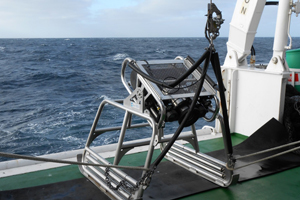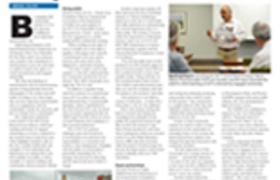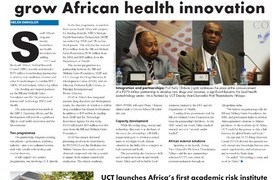Fisheries' footprint
23 June 2014
An experiment in the Atlantic Ocean 100 nautical miles off Hondeklipbaai on the west coast of South Africa will tell UCT marine researchers how long the seabed – and its ecosystem – takes to recover after hake trawling operations.
The Benthic Trawl Experiment is a joint research project with the South African Deep Sea Trawl Industry Association, the South African Environmental Observation Network (SAEON), and the Department of Agriculture, Forestry and Fisheries.
It's the first in a series of experimental surveys of the impact of bottom trawling on the benthic communities – organisms that live in or on the seafloor – of the outer shelf of South Africa's west coast, says chief scientist Associate Professor Colin Attwood. These will be conducted annually, though Attwood says it will take longer than the allotted four years for previously trawled lanes to bounce back.
Monitoring change
SAEON's Lara Atkinson, who is managing the project, says: "We have been planning for a long time to get this experiment under way, and we're very excited about this opportunity to be able to monitor for any changes in the benthic communities in the areas where trawling has stopped."
The experiment established a 6-by-15-nautical-mile block (within one of the fisheries' commercial blocks) and divided this into five lanes, two of which will remain open to trawling. The remaining three will be closed over the project's lifespan.
Data recovered during repeated surveys over this time will give researchers a clearer idea of recovery among seafloor species – and of the ocean floor itself, which becomes churned up by metal trawl 'doors' (some weighing up to 10 tons) angled to hold open the net mouth as it's pulled along.
A towed camera and a Van Veen grab (instrumentation used to collect sediment) will be used to sample the benthic epifauna and infauna respectively.
New footage
Two-and-a-half hours of video footage of the seabed, shot during the first of the experimental surveys on board the research vessel Ellen Khuzwayo in February, show marine life previously not seen on the seabed: jacopever, spiny eels, starfish, anemones and other crustaceans – and hake.
"The footage is very clear; it's the best and most systematic video we have of life in the trawl lanes," says Attwood.
Hake live in deep water during the day, the bulk at depths of 350-600m; and because of their inaccessibility, they aren't often observed in their wild habitat. But they migrate vertically, coming up to feed at night. As such, much of the trawling is done during the day when the fish are near the seabed.
"Mass food production has an environmental impact, and it's great that we have the fishing industry's co-operation on this experiment," says Attwood. "They understand that we need to limit harvest to replenishable numbers, and that it's important to work with the ecosystem."
Watch the video: Benthic Trawl Experiment 2014
Story by Helen Swingler. Photo courtesy of Assoc Prof Colin Attwood.
 This work is licensed under a Creative Commons Attribution-NoDerivatives 4.0 International License.
This work is licensed under a Creative Commons Attribution-NoDerivatives 4.0 International License.
Please view the republishing articles page for more information.
News
Faculty Focus - Humanities
Opinions
Photo Essay
Front page
Previous Editions










